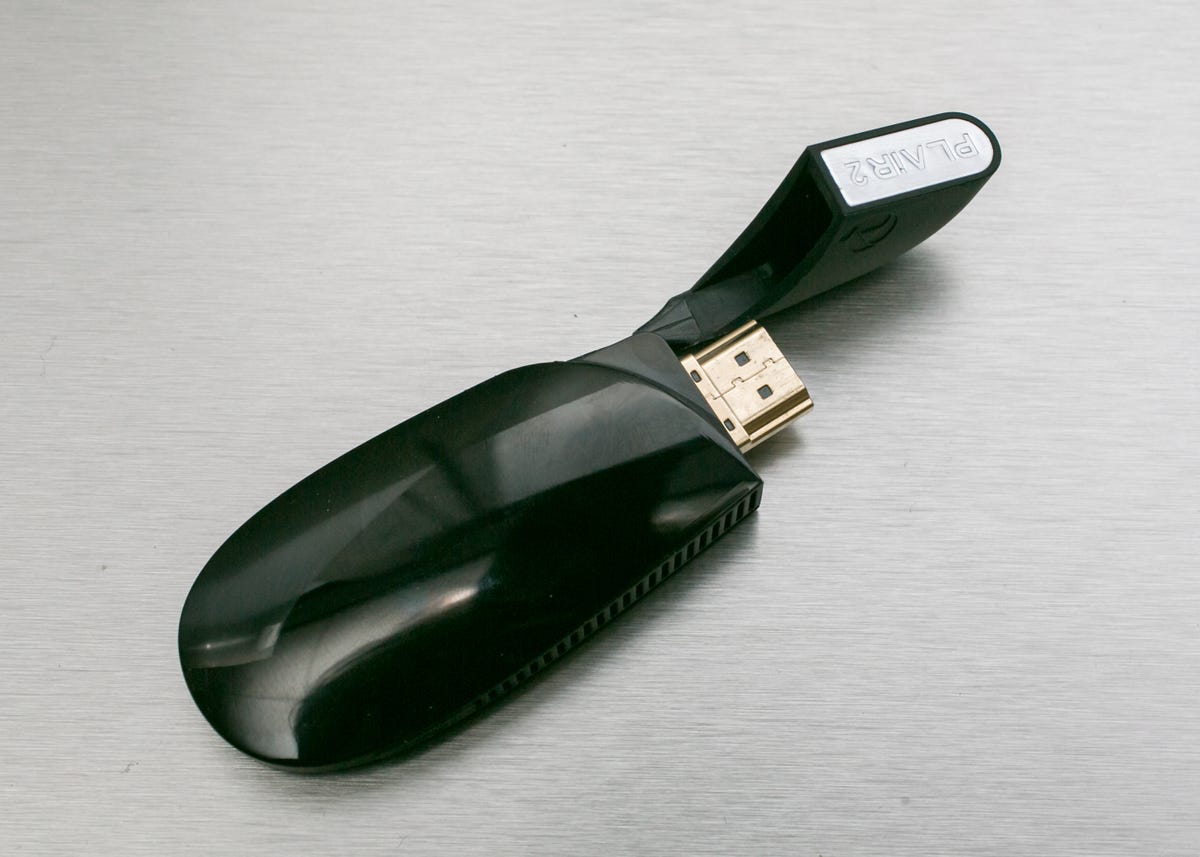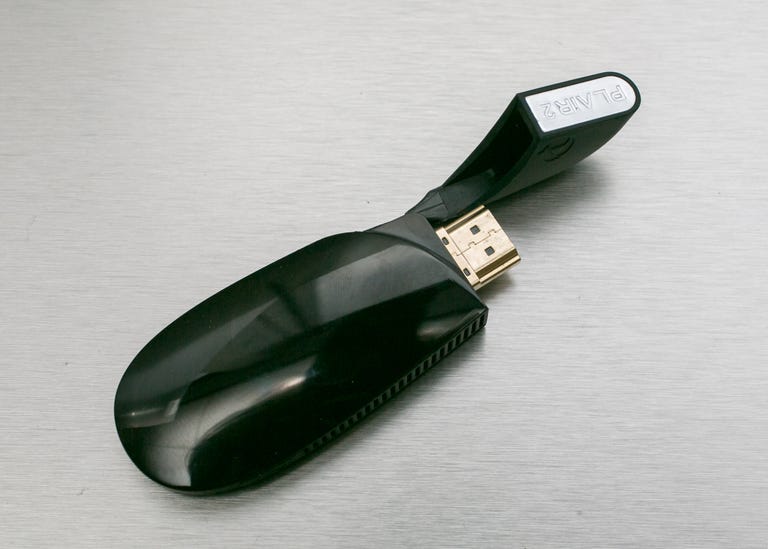 Why You Can Trust CNET
Why You Can Trust CNET Plair 2 review: A plucky Chromecast competitor misses the mark
Plair 2 is an interesting Chromecast alternative that offers access to the full suite of Android apps, but it's just not reliable enough for us to recommend it.
Google's Chromecast seemed like an entirely new type of product when it was released, but it was predated by a few months by the Plair, a strikingly similar streaming stick that offered much of the same functionality. While the Plair concept was undeniably neat, the actual product experience was pretty lousy, with too little content and a lot of stability problems.
The Good
The Bad
The Bottom Line
Now Plair is back with the Plair 2 and a new approach. Instead of beaming video to the stick from smartphones and laptops, the Plair 2 actually run Android apps itself, theoretically giving you access to every app in the Google Play Store. That's the kind of flexibility many have desired from the Chromecast, and the Plair 2 is doing its best to compete on price too, coming in at a competitive $49. Even better, the company is doing right by its early adopters, offering to update first-gen Plairs for free, as long as you pay to ship the device to them.
Those changes had me optimistic heading into the review, but the experience ended up feeling a whole lot like using the first-generation model. Yes, there are more apps, but many of them don't work well and there are all sorts of bugs and glitches that detract from the experience. The apps and device itself still crash too frequently, plus the Plair 2 often becomes sluggish after a while. And the smartphone control scheme always feels more difficult than it should, especially compared with just using a standard remote.
As with the original Plair, there's some merit to the Plair 2's approach, but it's too unreliable to recommend in its current state. With the
Design: The other streaming stick
The hardware of the Plair 2 is identical to that of the original Plair. It's a sleek, teardrop-shaped stick that you plug into one of your TV's HDMI inputs. To power the unit, you can connect the Plair 2 to your TV's USB port (if it has one); otherwise there's an included power adapter. It's a lot like a Chromecast, except Plair was first.

When I reviewed the original Plair, I had some serious complaints about the design of the hardware, which started with the device splitting apart when I pulled it out of the box. I had a better experience with the Plair 2; for one, it stayed in one piece. Apparently the hardware is unchanged from the first-gen model, so it's possible I just got a better review unit this time around. Overall, the stick still doesn't feel as solid as the Chromecast, but the build quality bothered me less this time around, especially for a device that will live behind your TV.
Setup: Cross your fingers
Once you have the Plair 2 installed in the back of your TV, the stick creates a local Wi-Fi hot spot. Load up the app on your tablet or smartphone and it guides you through the process.
My first attempt at setup using an iPhone 5S failed, as the app kept crashing before the final setup. Plair says it's an issue with the recent iOS 7 update and a fix is on the way. I switched over to a Nexus 7 for setup and got it working, although not without having the Android app crash once before finishing. Once I finally got the Plair 2 set up, I was able to control it via the iPhone 5S or the Nexus 7.
However, at some point during my testing, the Plair 2 lost the connection to my router and I wasn't able to successfully set it up again. While I'd be willing to chalk that up to the crowded wireless spectrum in the office, I've had no problems streaming from four different Roku boxes, the Google Chromecast, and the
The app and the interface
When I first saw the Plair 2, I was skeptical about the app-based control scheme, but it seemed to work surprisingly well during the product demo. However, those original doubts crept back once I started testing it myself.
The app is broken into a few sections. At the top is a large space for controlling the onscreen cursor. Below that is a section for swiping left and right, which is the easiest way to zip through the main interface. At the bottom are a few direct buttons to adjust the volume or just to the home screen.
The app gets some things right. It's nice to be able to pop up the keyboard at any moment to type in search terms, and it's designed so you rarely have to split your attention between the touch screen and your TV.
But mostly, controlling the Plair 2 felt harder than it should be. The control scheme just didn't seem responsive and intuitive enough, as I often overshot the app I wanted when swiping or the screen wouldn't scroll down when I wanted it to. There's also typically no quick way to pause video content once it's playing. For example, using Netflix you need to navigate the onscreen cursor to an onscreen pause button, but it can take a few seconds, depending on your skill with the cursor.
Perhaps the control scheme just isn't for me; I'm on the record as preferring real buttons to the virtual ones. But even accounting for that, I frequently found the device not responding the way I wanted it to and taking longer than it should for simple tasks. I'd prefer a Roku LT with a regular remote any day.
What's there to stream
The concept that's made Plair so interesting from the start is its commitment to letting you play a wide variety of Web video content on your TV. With the original Plair, that was done via screen mirroring, but with the Plair 2 the idea is that you should be able to install and use any app available in the Google Play store. The reality is a little more underwhelming.
The good news is that several major apps come preinstalled, including Netflix, Hulu Plus, HBO Go, Crackle, CNN, Pandora, NHL GameCenter, Spotify, and Xfinity. That's a big step up from the first-gen Plair, which didn't support any apps natively.
The bad news is that even though the Plair 2 theoretically has more content sources than, say, a Roku LT, I ended up feeling like there was more I wanted to stream on a Roku. I couldn't find an Amazon Instant or PBS app on Plair, two major apps I use frequently on my Roku 3. (Apparently you can access them via screen mirroring, which I didn't test this time around.) HBO Go works, but only in standard definition. And several of the "supported" apps weren't reliable in my testing.
Image quality and reliability, or lack thereof
While Hulu Plus and Xfinity are technically supported, I couldn't get any of them to stream reliably. Hulu Plus would get stuck in a "buffering" loop. The ability to stream from Xfinity's app sounds awesome, but I tried three different shows and never made it through a full episode without the video entirely freezing before the end. I eventually got a live stream of CNN up, but every time the app would automatically adjust its image quality, the entire screen would flash a few times.
Netflix worked most times, although it still crashed once during testing. Image quality on Netflix was decent, but there were still issues. For one, all of the video content using the Plair 2 is subject to a slight bit of windowboxing; in other words, it doesn't quite fill your entire TV screen. You can get rid of that by adjusting your TV's aspect ratio, but it's not a limitation any other video streamer suffers from. I also noticed some occasional jerkiness to video playback (likely due to dropped frames) that you don't expect from a Netflix streamer these days.
And even when image quality was decent, there were other hiccups that made the Plair 2 feel unpolished. At one point, an Android-style notification popped up letting me know about an injured NHL player, even though I never opened the NHL app during my testing. (It's installed by default.) Videos from Netflix and other sources often suffered from strange flashes of green during the first few minutes. Those eventually go away, but it's another set of annoyances you'll have to put up with on the Plair 2.
Finally, there's the issue of overall reliability. Once you run a few apps, the Plair 2 seems to become unstable and sluggish, with apps becoming unresponsive and the device sometimes rebooting on its own. All of these issues happened with less than 10 hours of testing time on my part, which doesn't speak well for the day-to-day reliability of the device.
What are the alternatives?
The other difficulty with the Plair 2 is it faces two strong alternatives: the Roku LT and Google Chromecast.
The Roku LT is my favorite of the two, offering up over 1,000 channels, including Netflix, Amazon Instant, HBO Go, Hulu Plus, Pandora, MLB.TV, Amazon Cloud Player, and Vudu. Yes, it's limited to 720p output, but image quality is still excellent overall.
Also worth considering is the Google Chromecast, which is just $35 and has a similar form factor. Don't put too much stock in the screen-mirroring feature, which I've found doesn't work that well, but for basic, cheap streaming from services like Netflix, YouTube, Pandora, and Hulu Plus, it's worth considering. And it's much more reliable than the Plair 2.
Conclusion: Ahead of its time, again?
The Plair 2 is a better product than the original Plair, thanks to the lower price and support for major content sources like Netflix, Pandora, and Hulu Plus. But I still wouldn't recommend it in its current state, unless you're the kind of gadget enthusiast who can tolerate a lot of flakiness in the hopes that future firmware updates will improve reliability.
It's hard not to feel like the Plair 2 may be ahead of its time again, as the idea of a small, cheap TV device that offers access to the full Android ecosystem has some appeal. (And there are reports that Google TV may be reimagined as Android TV.) But the window for such a device may be shrinking, especially if Google's Chromecast continues to add content partners.


